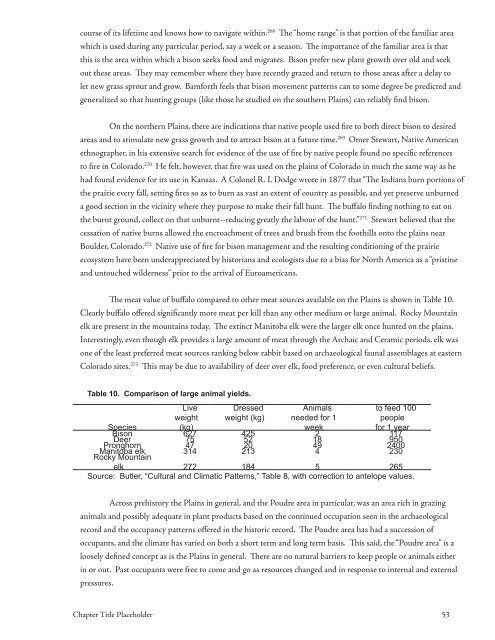People of the Poudre - Cache la Poudre National Heritage Area
People of the Poudre - Cache la Poudre National Heritage Area
People of the Poudre - Cache la Poudre National Heritage Area
You also want an ePaper? Increase the reach of your titles
YUMPU automatically turns print PDFs into web optimized ePapers that Google loves.
course <strong>of</strong> its lifetime and knows how to navigate within. 268 The “home range” is that portion <strong>of</strong> <strong>the</strong> familiar areawhich is used during any particu<strong>la</strong>r period, say a week or a season. The importance <strong>of</strong> <strong>the</strong> familiar area is thatthis is <strong>the</strong> area within which a bison seeks food and migrates. Bison prefer new p<strong>la</strong>nt growth over old and seekout <strong>the</strong>se areas. They may remember where <strong>the</strong>y have recently grazed and return to those areas after a de<strong>la</strong>y tolet new grass sprout and grow. Bamforth feels that bison movement patterns can to some degree be predicted andgeneralized so that hunting groups (like those he studied on <strong>the</strong> sou<strong>the</strong>rn P<strong>la</strong>ins) can reliably find bison.On <strong>the</strong> nor<strong>the</strong>rn P<strong>la</strong>ins, <strong>the</strong>re are indications that native people used fire to both direct bison to desiredareas and to stimu<strong>la</strong>te new grass growth and to attract bison at a future time. 269 Omer Stewart, Native Americanethnographer, in his extensive search for evidence <strong>of</strong> <strong>the</strong> use <strong>of</strong> fire by native people found no specific referencesto fire in Colorado. 270 He felt, however, that fire was used on <strong>the</strong> p<strong>la</strong>ins <strong>of</strong> Colorado in much <strong>the</strong> same way as hehad found evidence for its use in Kansas. A Colonel R. I. Dodge wrote in 1877 that “The Indians burn portions <strong>of</strong><strong>the</strong> prairie every fall, setting fires so as to burn as vast an extent <strong>of</strong> country as possible, and yet preserve unburneda good section in <strong>the</strong> vicinity where <strong>the</strong>y purpose to make <strong>the</strong>ir fall hunt. The buffalo finding nothing to eat on<strong>the</strong> burnt ground, collect on that unburnt--reducing greatly <strong>the</strong> <strong>la</strong>bour <strong>of</strong> <strong>the</strong> hunt.” 271 Stewart believed that <strong>the</strong>cessation <strong>of</strong> native burns allowed <strong>the</strong> encroachment <strong>of</strong> trees and brush from <strong>the</strong> foothills onto <strong>the</strong> p<strong>la</strong>ins nearBoulder, Colorado. 272 Native use <strong>of</strong> fire for bison management and <strong>the</strong> resulting conditioning <strong>of</strong> <strong>the</strong> prairieecosystem have been underappreciated by historians and ecologists due to a bias for North America as a “pristineand untouched wilderness” prior to <strong>the</strong> arrival <strong>of</strong> Euroamericans.The meat value <strong>of</strong> buffalo compared to o<strong>the</strong>r meat sources avai<strong>la</strong>ble on <strong>the</strong> P<strong>la</strong>ins is shown in Table 10.Clearly buffalo <strong>of</strong>fered significantly more meat per kill than any o<strong>the</strong>r medium or <strong>la</strong>rge animal. Rocky Mountainelk are present in <strong>the</strong> mountains today. The extinct Manitoba elk were <strong>the</strong> <strong>la</strong>rger elk once hunted on <strong>the</strong> p<strong>la</strong>ins.Interestingly, even though elk provides a <strong>la</strong>rge amount <strong>of</strong> meat through <strong>the</strong> Archaic and Ceramic periods, elk wasone <strong>of</strong> <strong>the</strong> least preferred meat sources ranking below rabbit based on archaeological faunal assemb<strong>la</strong>ges at easternColorado sites. 273 This may be due to avai<strong>la</strong>bility <strong>of</strong> deer over elk, food preference, or even cultural beliefs.Table 10. Comparison <strong>of</strong> <strong>la</strong>rge animal yields.Liveweight(kg)Dressedweight (kg)Animalsneeded for 1weekto feed 100peoplefor 1 yearSpeciesBison 627 425 2 117Deer 75 52 18 950Pronghorn 47 20 49 2400Manitoba elk 314 213 4 230Rocky Mountainelk 272 184 5 265Source: Butler, “Cultural and Climatic Patterns,” Table 8, with correction to antelope values.Across prehistory <strong>the</strong> P<strong>la</strong>ins in general, and <strong>the</strong> <strong>Poudre</strong> area in particu<strong>la</strong>r, was an area rich in grazinganimals and possibly adequate in p<strong>la</strong>nt products based on <strong>the</strong> continued occupation seen in <strong>the</strong> archaeologicalrecord and <strong>the</strong> occupancy patterns <strong>of</strong>fered in <strong>the</strong> historic record. The <strong>Poudre</strong> area has had a succession <strong>of</strong>occupants, and <strong>the</strong> climate has varied on both a short term and long term basis. This said, <strong>the</strong> “<strong>Poudre</strong> area” is aloosely defined concept as is <strong>the</strong> P<strong>la</strong>ins in general. There are no natural barriers to keep people or animals ei<strong>the</strong>rin or out. Past occupants were free to come and go as resources changed and in response to internal and externalpressures.Chapter Title P<strong>la</strong>ceholder 53


